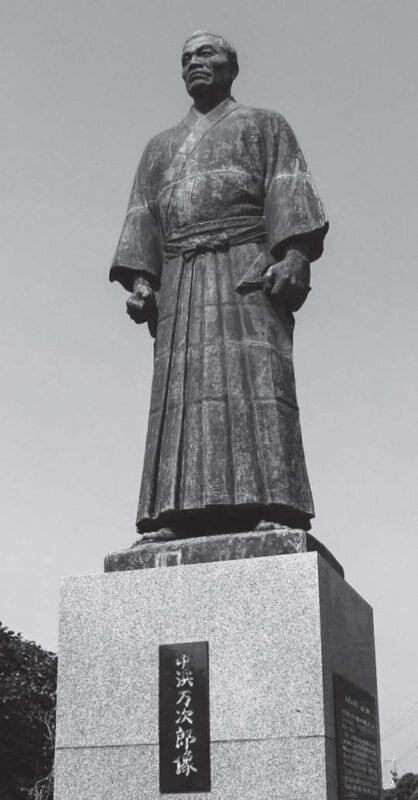Manjiro Nakahama: The First Japanese U.S. Resident
On May 7, 1843, a 16-year-old named Manjiro Nakahama became America’s first Japanese-born U.S. resident. Manjiro Nakahama, or more traditionally, Nakahama Manjirō (中濱 万次郎, January 27, 1827 – November 12, 1898), was an apprentice fisherman who, along with four others, was stranded for six months in 1841 on the uninhabited island of Torishima, 300 miles off the coast of Japan. The five fisherman, Denzo, Goemon, Jusuke, and Toraemon, and the then 14-year-old apprentice, Manjiro, were rescued by the U.S. whaling ship the John Howland, which was commanded by U.S. sea captain and Massachusetts native, William H. Whitfield.
Image at left: a portrait of Manjiro Nakahama, retrieved from https://www.ndl.go.jp/portrait/e/datas/6123/
Captain William H. Whitfield and the crew of the John Howland were in the midst of a five-year voyage in the Pacific when they discovered the shipwrecked Manjiro and his crew mates. At the end of this voyage in 1843, the John Howland came to port in the then Hawaiian Kingdom’s Honolulu, where Denzo, Goemon, Jusuke, and Toraemon, disembarked. Manjiro, who was then going by the Americanized nickname of John Mung, remained onboard, traveling with Whitfield to his hometown of Fairhaven, Massachusetts.
Image at right: These sketches, which depict the John Howland, were created by Manjirō and signed John Mung. They are part of a set Manjirō produced when relating his worldly adventures following his return to Japan. Image courtesy of the Rosenbach Museum & Library and retrieved from https://www.hakaimagazine.com/article-short/manjiro-nakahama-castaway-samurai/
William H. Whitfield (1804 - 1886) assumed the role of foster father or guardian in Manjiro’s life, providing for his care and seeing to his education until he reached maturity in 1846. Whitfield and his wife, Albertina (nee Kieth, 1811 - 1890), treated Manjiro as a respected member of the family and even changed churches following attempts by their own church to segregate Manjiro from the rest of the congregation.
Image at left: William H. Whitfield, retrieved from https://fairhaventours.com/capt-william-h-whitfield/
In Fairview, Massachusetts, Manjiro apprenticed with a blacksmith and briefly attended elementary school before enrolling in the prestigious Fairhaven Bartlett Academy where he studied English and navigation, among other subjects. After Manjiro completed his education 1846, Whitfield aided in securing a position for his ward among the crew of the Franklin, a whaling vessel captained by Ira Davis, which was set to commence a 30-month voyage in the South Seas. In 1847, the Franklin put to port in Honolulu, Hawaii, where Manjiro briefly caught up with his friends and former shipwrecked companions before continuing on his travels.
Map held in the collections of the Tokoyo National Museum. Image retrieved from https://www.wikiwand.com/en/Nakahama_Manjir%C5%8D.
On this map, Manjiro depicted his travels after he returned to Japan, with the lines drawn on the map showing the voyages of the John Howland and the Franklin.
After finishing his tour with the Franklin in 1849, Manjiro returned to Massachusetts with $350 in earnings. His stay in Massachusetts was short-lived however; as he learned of the California Gold Rush and hoped it would make his plan of returning to Japan a reality for himself and his friends. Manjiro never stopped longing for home and to see his mother again, but he reportedly also wished to return in order to help facilitate Japan’s reemergence on the global stage.
Along with the thousands of ‘49s that sought their fortune in the Gold Rush, Manjiro headed to California. In November of 1849, Manjiro left Massachusetts as a sailor aboard the Stieglitz, a merchant ship destined for San Francisco with a cargo of lumber. The Stieglitz arrived in May of the following year.
By 1850, Manjiro was back in Hawaii, having quickly accumulated $600 in wealth from gold mining in California. With his earnings, he bought passage aboard the Sarah Boyd (pictured at left), a ship that would pass near to Japan. He also purchased a small whale boat called the Adventure, which was capable of transporting him and his friends from the ship to the shores of Japan.
In December 1850, Manjiro and his friends Denzo and Goemon, set sail for home. Jusuke had died from heart disease five years earlier, and Toraemon had elected to remain in Hawaii. After ten years away from their native home, Manjiro, Denzo, and Goemon were back in Japan, landing in Okinawa in February 1851.
The three returned castaways were questioned by authorities and then held under house arrest in Okinawa for six months before being moved to Nagasaki for ten additional months of interrogation. They were finally released in June 1852. While they were still under travel restrictions, forbidden from leaving their hometown and most certainly from venturing to sea again, their treatment was quite liberal, all things considered. This was, after all, the era of Edo or Sakoku, a 200 plus year period of strict isolationism in Japan.
During Sakoku, under Shogun rule, any Japanese citizen who left the country for any reason was punished harshly. Returning home was a risky prospect, one that could result in execution, hence the reason Manjiro’s friend Toraemon decided to stay in Hawaii. During this era, violent storms often washed fishermen out to sea, far outside of Japanese territory. Most never returned home for fear of losing their lives upon arrival. Even when the exodus from Japan was the result of such fateful circumstances as a shipwreck, violators were viewed as dishonorable traitors that put the Japanese people at risk.
This belief system was entrenched and supported by more than 200 years of tradition and laws, which makes the next chapter of Manjiro’s life even that much more remarkable. Rather than being further detained or executed, Manjiro was made a samurai in direct service to the Shogun and with orders to educate other samurai on foreign affairs.
In July of 1853, just a year after Manjiro was released from detention, American Commodor Matthew C. Perry led a squadron of ships into Edo (Tokoyo) Bay to deliver a letter from President Millard Fillmore to the emperor of Japan. That letter demanded Japan open it’s ports and begin interacting with the western world again. Perry and his fleet retreated but promised to return in the spring for Japan’s response. These events, among others, made Manjiro an even more vital resource for Japanese leadership, as his knowledge of the United States and U.S. naval capabilities was unrivaled and indispensable.
Manjiro was made a samurai to the Shogun and played a central role in preparing the shogunate for the end of the Sakoku era and in educating Japanese students and teachers in the subjects of English, American culture, and navigation. In fact, he was appointed a professor at the Shogunate’s Naval Training School, helping to bring the Japanese navy into the modern era, allowing for effective trans-Pacific travel by 1860.
When Manjiro was first rescued by Captain Whitfield, he had no surname. Japan was a strict class culture, and fishermen were the lowest of the low. Possessing a surname was an honor reserved for the upper classes. It was therefore not until Manjiro served as a Samurai to the Shogun that he was permitted to take a surname. He chose Nakahama himself, honoring his hometown by doing so.
Manjiro continued to serve the shogun, and later the restored imperial government, in various capacities and also expanded his own knowledge and education to that end. Following an 1870 educational mission to Europe, Manjiro visited the east coast of the United States and Captain William Whitfield for the first time in 21 years.
Image: “John Manjiro and Bearded Man,” Digital Public Library of America, https://dp.la/item/684e943e612f8fb61f56abab95ba8721.
This image of Manjiro dates to the 1870s, when he returned to Massachusetts to visit friends and “family,” including Captain William Whitfield, who may or may not be the bearded man pictured here.
According to the Whitfield - Majiro Friendship Society in Fairhaven, Massachussets, Manjiro’s contributions later in life include, but are by no means limited to the following:
The translation of “The New American Practical Navigator” into Japanese
Appointed professor of Navigation at the Shogun Naval Training School
Author of “Eibei Taiwa Shokei” (A shortcut to Anglo-American Conversation), which was the first English textbook ever published in Japan
Served as the official translator for Japan’s first delegation of representatives to visit the United States, which arrived in San Francisco aboard the Kanrin-maru in 1860
Appointed professor to Kaisei University, the forerunner of Tokyo Imperial University (known today as Todai University)
Image at left: Statue of Nakahama Manjirō at Cape Ashizuri, Tosashimizu, Kochi Prefecture, Island of Shikoku, Japan. Retrieved from Wikimedia Commons at http://tinyurl.com/o85hrg9.
While Manjiro Nakahama was Japan’s first U.S. resident, he was not the first or only Japanese person to visit the United States in the years prior to widespread Japanese immigration, which commenced in the 1880s. Although there were Japanese that immigrated to the Hawaiian Islands in the late 1860s, often to work on sugarcane plantations, Hawaii was still an independent nation at the time. Some of these sugarcane workers later migrated to the Mainland U.S., settling in California, Washington, and Oregon where they were largely farmers and fishermen.
Also in the 1860s, a few immigrants made their way directly from Japan to California, but their numbers were so low that their presence went largely unnoticed at least in terms of being an independent ethnicity. This was due in large part to the influx of immigrants from other parts of Asia, particularly China in the late 1840s and 1850s. In fact, by 1900, there were still fewer than 25,000 Japanese nationals living in the entire United States.
Manjiro Nakahama died in 1898, at the age of 72, and although Japanese immigration to the United States at the time was still minimal, he lived long enough to see his dream of an “Open Japan” become reality.
Image at right: Manjiro Nakahama, ca. 1880, retrieved from https://www.newworldencyclopedia.org/entry/Nakahama_Manjir%C5%8D
Sources:
[1] “Nakahama Manjirō.” Accessed 10 May 2021 from https://www.wikiwand.com/en/Nakahama_Manjir%C5%8D
[2] “John Manjiro: The First Japanese to Reach America,” Inspiring Biographies, blog post, Aug 4 2010. Accessed 10 May 2021 from http://inspiringbiographies.blogspot.com/2010/08/john-manjiro-first-japanese-to-reach.html
[3] Kikuoka, T., The Presentation of a Samurai Sword. The Millicent Library (Fairhaven, Massachusetts), 1982. Digital image, accessed 10 May 2021 from https://millicentlibrary.org/wp-content/uploads/2017/10/SwordBooklet-1982.pdf
[4] “Asian American Milestones: Timeline,” History.com, Mar 22, 2021. Accessed 10 May 2021 from https://www.history.com/topics/immigration/asian-american-timeline
[6] Kingdon, Amorina. “Manjirō Nakahama: From Castaway to Samuri,” Hakai Magazine (2015), accessed 10 May 2021 from https://www.hakaimagazine.com/article-short/manjiro-nakahama-castaway-samurai/
[7] Albertina P. Keith Whitfield. Find a Grave, online memorial, accessed 10 May 2021 from https://www.findagrave.com/memorial/148203881/albertina-p-whitfield
[8] Kitadai, Junji. “The Sage of Manjirō” Education About Asia, Volume 19:2 (Fall 2014): Maritime Asia. Online archive, accessed 10 May 2021 from https://www.asianstudies.org/publications/eaa/archives/the-saga-of-manjiro/
[9] “The Manjiro Story” Accessed 10 May 2021 from https://whitfield-manjiro.org/the-manjiro-story/
[10] “Nakahama Manjirō” Accessed 10 May 2021 from https://www.newworldencyclopedia.org/entry/Nakahama_Manjir%C5%8D
[11] “Japanese Immigration” Accessed 10 May 2021 from https://americanhistory.si.edu/righting-wrong-japanese-americans-and-world-war-ii/japanese-immigration
[12] “The U.S. Mainland: Growth and Resistance” Accessed 10 May 2021 from https://www.loc.gov/classroom-materials/immigration/japanese/the-us-mainland-growth-and-resistance/











